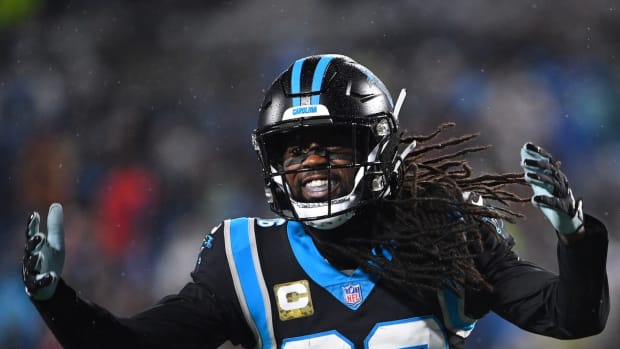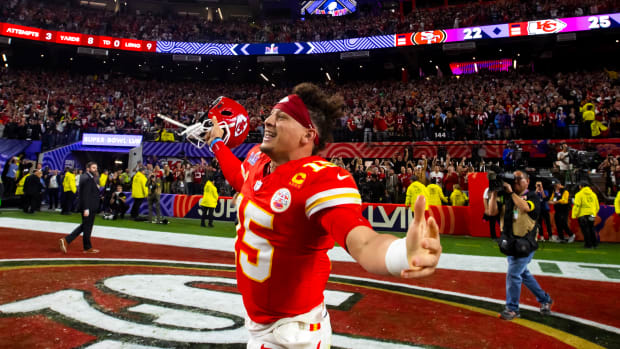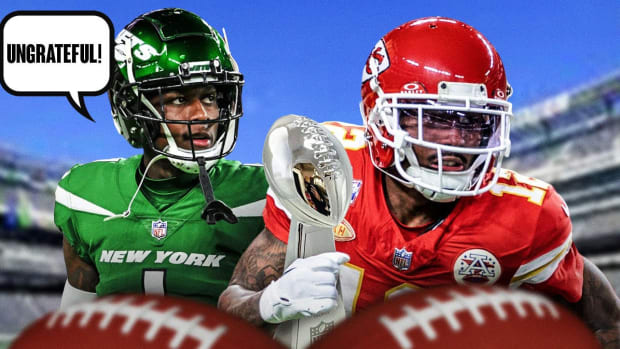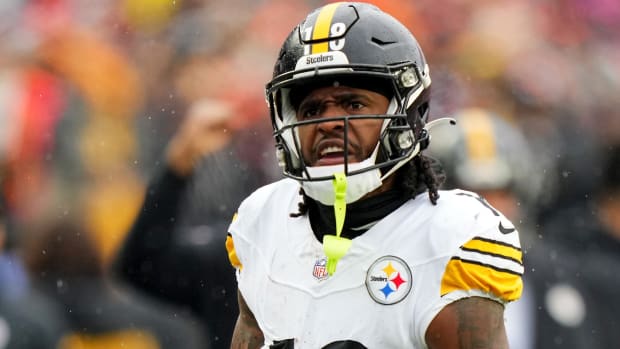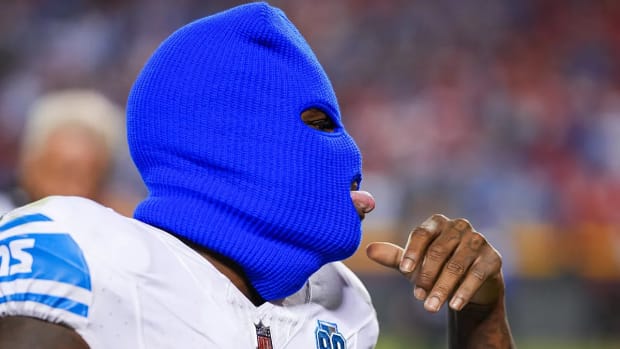Ranking the NFL's Neediest Teams
This story appears in the Feb. 12, 2017, issue of SPORTS ILLUSTRATED. To subscribe, click here.
1. NEW YORK JETS (5–11)
FIRST-ROUND DRAFT PICK: 6
PRIMARY NEED: BEST PLAYER AVAILABLE
The Jets wildly surpassed expectations by winning five games... which says everything about this roster. There are enough glaring needs that GM Mike Maccagnan can draft his board’s top player in the first four rounds and trust that each rookie will immediately have a major role. Quarterback is the most significant need. After that: interior O-line, tight end, linebacker, cornerback.... How each spot is filled could influence the others. Coach Todd Bowles is known for blitzing, but he’s disciplined about playing to personnel. A stud corner would allow Bowles to use more pressure packages, but if there’s a pass rusher New York loves, the coach could rework around him.
2. CLEVELAND BROWNS (0–16)
FIRST-ROUND DRAFT PICK: 1, 4 (VIA TEXANS)
PRIMARY NEED: SLOT RECEIVER
The Browns are more talented than their 0–16 record suggests. They could use another playmaker or two on D (what last-place team couldn’t?), but more than anything, they need to redesign their O. Part of DeShone Kizer’s struggles at QB can be attributed to coach Hue Jackson’s asking the rookie to make deep, full-field progression reads out of spread formations. It doesn’t get more challenging than that. Jackson is a shrewd offensive strategist; his unit can be better—especially if he has a true slot receiver around whom he can build shorter route combos, increasing the ways versatile receiving back Duke Johnson and nimble tight end David Njoku are used.
3. BUFFALO BILLS (9–7)
FIRST-ROUND DRAFT PICK: 21, 22 (VIA CHIEFS)
PRIMARY NEED: EDGE RUSHER
The Bills’ biggest need is at QB, but that’s true for just about any team without a franchise guy in that spot. Digging deeper, look to the D-line. Coach Sean McDermott is a creative, effective blitz schemer. But he more often plays traditional zone coverages, which require a potent four-man rush. Buffalo had just 27 sacks last season, tied for third fewest in the NFL, and you can see that reflected on film: Their front four rarely controlled games. This roster’s only viable pass rusher is defensive end Jerry Hughes, who can go quiet for stretches. The Bills need an edge bender opposite him, as well as a penetrator inside, especially if 34-year-old free agent Kyle Williams does not return.
4. CHICAGO BEARS (5–11)
FIRST-ROUND DRAFT PICK: 8
PRIMARY NEED: WIDE RECEIVER
The offense that new coach Matt Nagy coordinated under Andy Reid in K.C. prospered despite mediocre receivers. But that was a function of Reid’s passing-game creativity with running backs, plus the presence of multi-tooled tight end Travis Kelce. Nagy can employ his backs in the air (especially the electrifying Tarik Cohen), but tight ends Dion Sims and Adam Shaheen are neither dynamic nor flexible. In his second year, quarterback Mitchell Trubisky will need more talented receivers. Cameron Meredith, coming off a left-ACL tear, can fill one spot—but that leaves three more. Just about any style of player will work here, as long as he’s a proficient enough route runner to aid the timing and rhythm throws that Trubisky’s success will hinge on.
5. INDIANAPOLIS COLTS (4–12)
FIRST-ROUND DRAFT PICK: 3
PRIMARY NEED: EDGE RUSHER
Everyone derides the Colts’ offensive line, but third-year center Ryan Kelly and guards Jack Mewhort (entering year five) and Joe Haeg (three) form a solid, improving interior; and Anthony Castonzo is a quality left tackle. The real problem: Injuries have kept these guys from playing together. Chemistry can develop once they stay healthy. Instead of meddling there, expect second-year GM Chris Ballard to use his cap space ($84 million) and early draft picks to restock a defense that ranked 30th last season and needs work at every position except tackle and free safety. The fastest way to improve a defense is to add an edge rusher who can influence an opposing offense’s blocking scheme and make the quarterback play hastily.
6. CINCINNATI BENGALS (7–9)
FIRST-ROUND DRAFT PICK: 12
PRIMARY NEED: QUARTERBACK
This is as much about a franchise philosophy as it is about Andy Dalton in particular. The Bengals’ approach has long been to pay for a middle-tier QB and surround him with talent, investing early picks at receiver, running back, tight end and offensive tackle. With Dalton there have been ups and downs (dictated largely by how well he moves within the pocket), and all but one of his seven campaigns have ended somewhere between 6–10 and 11–5. That’s respectable but ultimately unfulfilling. If owner Mike Brown is unwilling to change leadership at the coaching level, he at least needs to evolve Cincinnati’s on-field identity. This year’s draft offers at least four first-round QBs, and Dalton would count just $2.4 million in dead money against the cap if he was released.
7. TENNESSEE TITANS (9–7)
FIRST-ROUND DRAFT PICK: 25
PRIMARY NEED: WIDE RECEIVER
Sure, the Titans drafted Corey Davis with the No. 5 pick last year. But he has yet to show the transitional quickness or top-end speed to stretch the field. Barring a sudden turbo boost (which we might see once he acclimates more to the NFL), Davis will most likely build his career on contested catches and possession targets. In other words: Tennessee doesn’t have anyone who can threaten a defense deep, and that makes every part of the passing game more difficult. (There’s also the matter of Eric Decker’s free agency in 2018, and Rishard Matthews’s in ’19.) Finding a speed receiver with upside to pair with Davis and fellow ’17 rookie Taywan Taylor (a quintessential slot man) would be prudent.
8. ARIZONA CARDINALS (8–8)
FIRST-ROUND DRAFT PICK: 15
PRIMARY NEED: OFFENSE
New coach Steve Wilks inherited the defensive talent to run his blitz-intensive scheme. On the other side of the ball, there’s barely the personnel to run any scheme. There’s no quarterback under contract; starting guards Alex Boone and Earl Watford are both free agents; so is wide receiver Jaron Brown; and Larry Fitzgerald’s return is up in the air. Cardinals general manager Steve Keim, in other words, has plenty of work to do. The silver lining: New offensive coordinator Mike McCoy is an adaptable play-caller with a strong grasp of modern passing concepts. Arizona can mold its system to fit just about any quarterback. If Keim can’t get in on the rookie QB action through this year’s draft, he’ll find a bridge guy and draft men to block and catch for whichever passer comes next year.
9. WASHINGTON REDSKINS (7–9)
FIRST-ROUND DRAFT PICK: 13
PRIMARY NEEDS: WIDE RECEIVER, LINEBACKER
Alex Smith is a downgrade from Kirk Cousins, but he can be serviceable with the right weapons. The Redskins need to find those. Wide receiver is the top priority, especially if free agent Ryan Grant is not retained. If he returns, then linebacker becomes the top need. Speed demon Zach Brown was the only constant in 2017. Fans love him, but his performances are sometimes marred by misreads. It’ll be fascinating to see what kind of money he’s offered in free agency. Washington, a zone-based D, has no long-term depth around Brown, so linebacker will be addressed even if he sticks around.
10. TAMPA BAY BUCCANEERS (5–11)
FIRST-ROUND DRAFT PICK: 7
PRIMARY NEED: PASS RUSHER
It will be tempting to pursue a replacement for disappointing running back Doug Martin, especially considering that Charles Sims is also a free agent. But it’s far more important for the Bucs to get some teeth on a D that had no bite in 2017. This season was essentially lost when second-year end Noah Spence separated his shoulder in Week 3. He was the only edge-rushing threat; without him, Tampa’s pass rush floundered and its zone coverages were exposed. The Bucs need an infusion of pass-rushing talent to ensure a single injury doesn’t scuttle their D again. Currently, Gerald McCoy and—once or twice a game—Robert Ayers are the only forces who flash up front.
11. SAN FRANCISCO 49ERS (6–10)
FIRST-ROUND DRAFT PICK: 9/10
PRIMARY NEED: OFFENSIVE LINE
For Jimmy Garoppolo to be the QB savior that so many pundits imagine, he needs to be protected. Center Daniel Kilgore and right guard Brandon Fusco are free agents (and probably backups on most teams). At left guard, Laken Tomlinson has size and strength, but maybe not the ideal agility for Kyle Shanahan’s outside-zone running scheme. Something else to consider: Left tackle Joe Staley is 33. He was strong in pass protection last season, but he wasn’t impermeable. Shanahan often asks his tackles to block one-on-one, sending all five eligible receivers out in routes. That helps his QB throw quickly, which Garoppolo thrived doing in 2017. Because of this, the Niners don’t necessarily have to invest hugely in the O-line—but it wouldn’t hurt.
12. DENVER BRONCOS (5–11)
FIRST-ROUND DRAFT PICK: 5
PRIMARY NEED: RIGHT TACKLE
Next year’s QB is anyone’s guess. Paxton Lynch? Kirk Cousins? Some first-round prospect? Whoever lands the job will need better pass protection than the Broncos’ passers got in 2017. Right tackle is the spot of greatest concern: The talented but unrefined Menelik Watson was a turnstile, and long-armed Donald Stephenson (another nice player who has never put it all together) couldn’t stick in the starting lineup. Now: Stephenson’s a free agent and will most likely walk; Watson, who’s due $7.1 million, will probably be cut. Finding a reliable replacement would aid Denver’s undefined passing attack. (And if Watson somehow re-turns too? He could become a utility backup or guard, where he’s better suited.)
13. OAKLAND RAIDERS (6–10)
FIRST-ROUND DRAFT PICK: 9/10
PRIMARY NEED: WIDE RECEIVER
With his propensity for drops, Michael Crabtree and his $7.7 million cap number are not worth keeping. Two years ago, Crabtree’s fellow starting wideout, Amari Cooper, looked like the Next Big Thing—but injuries and his own slippery hands have been problematic. Also concerning: the way that Cooper, one of the league’s quicker and more nuanced route runners, struggles against press coverage. If his 2018 is like the second half of his ’16 or any of his ’17, his long-term role will be, at best, as a No. 2. The Raiders can make Cooper’s (and QB Derek Carr’s) life easier by finding a topflight bookend. One with size and the fearlessness to go inside would best fit in new coach Jon Gruden’s system.
14. MIAMI DOLPHINS (6–10)
FIRST-ROUND DRAFT PICK: 11
PRIMARY NEED: CORNERBACK
The Dolphins could fall in love with some quarterback, running back or receiver—but they ought to prioritize corner. Xavien Howard, a polished, agile second-rounder from 2016, is on the cusp of stardom, and across from him, coaches appear comfortable with ’17 third-round pick Cordrea Tankserley. But coach Adam Gase, a trips-formation evangelist, knows better than anyone that today’s NFL demands a solid slot corner too. Bobby McCain is decent, but his contract expires after ’18, and there’s no depth behind him. Miami should find a corner who has the spatial awareness to play zone inside but also the size to move outside as insurance for Tankersley. Someone fitting this description will cost a first-or second-round pick.
15. DETROIT LIONS (9–7)
FIRST-ROUND DRAFT PICK: 20
PRIMARY NEED: DEFENSIVE END
It’s funny. In 2016, Ziggy Ansah looked so much better on film than his two sacks suggested. In ’17 he had 12 takedowns but looked markedly worse. His playing time diminished and he slid into a pass-rushing-specialist role later in the year. Long and limber, Ansah has the potential to be elite, especially on stunts and D-line slants. And, yes, some of his inconsistencies can be attributed to knee and back injuries. Still, the Lions must think long and hard before applying the $18 million franchise tag to this free agent. If they don’t, another team will almost certainly overpay for him. Even if Ansah stays, a zone-based defense like the Lions’ can never have too many pass rushers. Detroit could definitely use another.
16. CAROLINA PANTHERS (11–5)
FIRST-ROUND DRAFT PICK: 24
PRIMARY NEED: OFFENSIVE LINE
It’s a myster how left guard Andrew Norwell—sturdy but by no means spectacular—earned first-team All-Pro. (No one on this line was All-Pro-worthy; that’s partly why the Panthers’ backs rushed for the second-fewest yards in the NFL.) This perplexing nod might beef up Norwell’s market value, and his franchise-tag number is already inflated by the NFL’s asinine practice of lumping all linemen into the same pricing category. Re-signing him could be tough, and while he’s the only 2018 free agent on this line, right tackle Daryl Williams will be up in ’19, as will center Ryan Kalil. Carolina must replenish its depth up front.
17. NEW YORK GIANTS (3–13)
FIRST-ROUND DRAFT PICK: 2
PRIMARY NEED: RUNNING BACK
If the Giants fall head over heels for one of this draft’s QBs, fine. But Eli Manning has shown little sign of decline. His poor 2017 should be resolved, partly, by a healthy receiving corps and a revamped system under new coach Pat Shurmur. Any scheme is stronger with a dynamic back, which New York hasn’t had since Ahmad Bradshaw in ’12. Last year’s fourth-round pick, Wayne Gallman, is intriguing, but not enough to build around. Orleans Darkwa, a better pure runner, could test free agency. So could Shane Vereen. If he leaves, the Giants will need a three-down weapon. If Vereen returns, they ought to get a first- and second-down bell cow, which shouldn’t be too expensive.
18. KANSAS CITY CHIEFS (10–6)
FIRST-ROUND DRAFT PICK: NONE
PRIMARY NEED: INTERIOR RUN DEFENDER
The Chiefs’ defensive front seven has had some rich individual talent, but collectively that group has finished 25th and 26th against the run the last two years. Part of the problem is coordinator Bob Sutton’s preference for a three-safety, three-corner dime package on second or third down when facing a three-receiver set (which is common in today’s NFL). Here the Chiefs almost always align in a light 4–2, and against agile runners they get gashed. If Sutton keeps this up, he must find an imposing every-down ’backer (Derrick Johnson, 35, is no longer that guy), plus another dynamic D-lineman in the mold of third-year pro Chris Jones.
19. LOS ANGELES RAMS (11–5)
FIRST-ROUND DRAFT PICK: 23
PRIMARY NEED: SECONDARY
The Rams’ best DBs—corner Trumaine Johnson and free safety LaMarcus Joyner—are free agents, but there’s enough cap room to re-sign both. If that doesn’t happen, any vacated position there becomes priority No. 1. Nickell Robey-Coleman is also headed for the open market, and his slot corner position could be hard to fill. If the Rams somehow return all three DBs, they’ll refocus on the edge. Connor Barwin is a free agent. Robert Quinn could be cut next year. (He isn’t as swift as he was in 2013, when he had 19 sacks, and he doesn’t have a refined array of pass-rushing moves.) L.A. needs more juice on the edge.
20. SEATTLE SEAHAWKS (9–7)
FIRST-ROUND DRAFT PICK: 18
PRIMARY NEED: DEFENSE
Four end-of-year starters are entering free agency: DT Sheldon Richardson, OLB Michael Wilhoite, SS Bradley McDougald and CB Byron Maxwell. More important, a trove of stars—DE Cliff Avril, SS Kam Chancellor and CB Richard Sherman—each suffered what are most likely career-altering (or -ending) injuries in 2017. Plus, DE Frank Clark, OLB K.J. Wright and FS Earl Thomas all become free agents in ’19. Retaining all three is unlikely; replacing even one will be hard. Coach Pete Carroll’s replacing coordinator Kris Richard with Ken Norton Jr., (who was Seattle’s linebackers coach from ’10 through ’14), suggests that he wants to get back to a Cover 3 foundation. And that suggests speed is the attribute he’ll look hardest for in rebuilding.
21. BALTIMORE RAVENS (9–7)
FIRST-ROUND DRAFT PICK: 16
PRIMARY NEED: EDGE RUSHER
THE INTERIOR O-line was the Ravens’ biggest weakness in 2017, but with Marshal Yanda (ankle) and Alex Lewis (shoulder) returning, guard should be set. Center Ryan Jensen (a free agent) improved greatly and is worth re-signing. Receiver is a position of need, and if Baltimore’s brass feel it’s time to give up on ’15 first-rounder Breshad Perriman, they’ll draft there. (Mike Wallace and Jeremy Maclin are an average duo.) But don’t be surprised if they focus on bolstering a D that’s already among the NFL’s best. You can never have too many edge rushers—especially if your only consistent one soon turns 36. Hello, Terrell Suggs! If an instant threat isn’t available in the draft, Baltimore needs a developmental replacement who can learn from Suggs.
22. HOUSTON TEXANS (4–12)
FIRST-ROUND DRAFT PICK: NONE
PRIMARY NEED: OFFENSIVE LINE
THE DESHAUN WATSON hype is justified. He’s a mobile out-of-pocket threat and has the potential to be one of the NFL’s best downfield passers. Those traits elevate his ceiling—but a QB’s floor is set by his capacity to play from the pocket. After Watson became the starter in Week 2, he grew more patient and polished from the pocket, but it’s hard to see that continuing if the Texans don’t shore up the NFL’s least talented line. Foes eagerly attacked with stunts and inside blitzes, and that constant assault can erode a QB’s pocket comfort. Houston must upgrade all five spots.
23. DALLAS COWBOYS (9–7)
FIRST-ROUND DRAFT PICK: 19
PRIMARY NEED: WIDE RECEIVER
Dez Bryant started slowing down in 2015. In ’16 top corners often defeated him. In ’17 defenses stopped giving those corners safety help, trusting that the 29-year-old Bryant—whose route tree was already limited to slants, posts and digs—could be handled one-on-one. (He was.) Dak Prescott is a quality QB, but his style and skill set require that he be surrounded by talent, and that starts with a perimeter receiver who can separate and influence coverages. Bryant, who averaged a little more than 50 yards per game since ’15, and whose cap number is $16.5 million, is not that receiver.
24. LOS ANGELES CHARGERS (9–7)
FIRST-ROUND DRAFT PICK: 17
PRIMARY NEED: FREE SAFETY
Defensive coordinator Gus Bradley’s best years as a play-caller came with the Seahawks in 2009–12. There he had the NFL’s rangiest free safety, Earl Thomas, which gives a coach (and 10 other defenders) the confidence to be aggressive. Bradley is mostly running his old Seahawks-style Cover 3 zone and single-high safety man-to-man in L.A. That demands superior personnel, which Bradley has in dominant edge rushers Melvin Ingram and Joey Bosa, plus a talented cornerbacking group led by Casey Hayward. A playmaking centerfielder would do wonders for this unit. Last year’s starter, Tre Boston, had his moments, but he’s a free agent—and not the type you break the bank to re-sign.
25. GREEN BAY PACKERS (7–9)
FIRST-ROUND DRAFT PICK: 14
PRIMARY NEED: CORNERBACK
From last year’s roster, only 2017 second-round pick Kevin King is a bona fide starter at corner (and that’s assuming he can build on a stellar rookie season). Davon House’s contract is up, and Damarious Randall, a ’15 first-rounder, has his peaks and valleys. A change at coordinator does little to assuage the need for a reliable cover corner opposite King. Dom Capers valued that role because it left more chess pieces for his pressure packages, and his replacement, Mike Pettine, thinks the same way. Pettine was the Jets’ coordinator in the Darrelle Revis years, when New York played solo coverage outside while ’backers and DBs were used interchangeably on inside pressure concepts.
26. JACKSONVILLE JAGUARS (10–6)
FIRST-ROUND DRAFT PICK: 29
PRIMARY NEED: TIGHT END
Regardless OF who’s at QB, this will remain a defensive-minded, run-first team. That approach becomes infinitely stronger with quality every-down tight ends. Really, you need two, which diversifies your formation options and your running game. It also fortifies your aerial attack, especially over the middle in this play-action-intensive scheme. The Jags had a solid-but-unspectacular tight end for 12 years in Marcedes Lewis, but with his $4 million contract now voidable, it’s time to look forward. (A quality pass catcher would be an improvement on backups Ben Koyack and James O’Shaugnessy.) Some of the NFL’s best developmental TEs have been drafted in the middle rounds.
27. MINNESOTA VIKINGS (13–3)
FIRST-ROUND DRAFT PICK: 30
PRIMARY NEED: DEFENSIVE TACKLE
Case Keenum is the QB the Vikings should re-sign. Sam Bradford can’t stay healthy, and Teddy Bridgewater has limitations. In the end, only one of those guys will stick, and GM Rick Spielman’s search will shift to the defense. The starting unit is rock-solid, so a luxury draft pick can be afforded if the right player is on the board. To plug future holes, the Vikes might also look to D-tackle, where free-agent rotational guys Tom Johnson and Shamar Stephen will most likely earn starter money on the open market. A project DT makes sense in the draft, given how successful Mike Zimmer has been at developing talent off his bench.
28. PHILADELPHIA EAGLES (13–3)
FIRST-ROUND DRAFT PICK: 32
PRIMARY NEED: OFFENSIVE TACKLE
Jason Peters was playing at a Pro Bowl level before tearing his right ACL and MCL in Week 7. Philly’s left tackle will be coming off the IR at age 36. Peters’s 2017 replacement, Halapoulivaati Vaitai, improved his pass-blocking technique through the back end of the year, but he still might be seen internally as a high-end backup. (He can play on either side.) Cutting Peters would save $5.3 million in cap space, but it would also carry $6.3 million in dead money. Optioning out of that contract a year later would save $8 million and cost nothing. Either way: If Peters departs, All-Pro right tackle Lane Johnson can move to the left, but that’d still leave a need on the right. (Vaitai?) With franchise QB Carson Wentz to protect, the Eagles won’t be chintzy in restocking the position.
29. NEW ORLEANS SAINTS (11–5)
FIRST-ROUND DRAFT PICK: 27
PRIMARY NEED: TIGHT END
With Sean Payton as the architect, Drew Brees the orchestrator and Alvin Kamara the headliner, the Saints have one of football’s most powerful offenses. A dynamic, versatile tight end—imagine the formations available alongside Kamara!—would make it borderline unstoppable. Saints fans will point out they once had this tight end: Jimmy Graham. And maybe they will again, given that his Seahawks contract is up. Even so, New Orleans—which is at its best when balanced in the run and pass, and which plays a lot more base personnel than people realize—would also need to develop a quality in-line blocker. (Graham is not that.) Incumbents Josh Hill and Michael Hoomanawanui are entering contract years; Coby Fleener, who’s pretty mediocre, can be released for a $3.4 million cap savings.
30. ATLANTA FALCONS (10–6)
FIRST-ROUND DRAFT PICK: 26
PRIMARY NEED: GUARD
Even with first-and-second-down D-linemen Dontari Poe, Adrian Clayborn, Courtney Upshaw and Ahtyba Rubin hitting free agency, the Falcons’ front is in fine shape. Every position on both sides of the line is set for the near future. Except guard. On the right, Wes Schweitzer, a sixth-round pick in 2016, improved late last year, particularly in pass protection, but he still has athletic limitations. Andy Levitre, 31, was solid on the left but finished the year on IR and now carries an $8.4 million cap number ($7 million of which can be scrapped with his release). Matt Ryan is at his best when climbing the pocket, so Atlanta will invest in that pocket’s cleanliness. Whoever they acquire must be mobile, too, as that’s critical in Atlanta’s outside-zone running scheme.
31. PITTSBURGH STEELERS (13–3)
FIRST-ROUND DRAFT PICK: 28
PRIMARY NEED: INSIDE LINEBACKER
This defense wasn’t the same after Ryan Shazier went down with a spinal injury. Shazier wasn’t always disciplined, but his speed and athletic, multidirectional burst brought a unique ferocity to the front seven. The Steelers’ No. 2 inside ’backer, Vince Williams, was one of the league’s most improved players (including as a blitzer), but he’s not quite an every-down guy. And much of coordinator Keith Butler’s scheme requires two of those. (At the very least he needs one in order to run his complex dime-package blitzes.) In base and nickel situations, Pittsburgh’s D-linemen often switch gap assignments after the snap. That high-risk, high-reward approach requires stable linebacking behind it.
32. NEW ENGLAND PATRIOTS (13–3)
FIRST-ROUND DRAFT PICK: 31
PRIMARY NEED: CORNERBACK
Last year’s $65 million signing of ex–Bills corner Stephon Gilmore was a tacit declaration that Malcolm Butler wouldn’t return in 2018. Butler, undrafted in ’14, has made $5.4 million as a pro—a fraction of what he’ll be offered in guarantees as this year’s top free-agent corner. He’s one of football’s rarest commodities: a cover artist who travels with smaller, agile receivers like Antonio Brown. He might not always shut them down, but the ability to even match up has lent coach Bill Belichick valuable coverage-design flexibility. The Patriots’ depth at corner is iffy already, and Eric Rowe will be a free agent after next season. With no other roster holes, don’t be shocked if New England, which plays a lot of man coverage, invests in multiple corners.



































